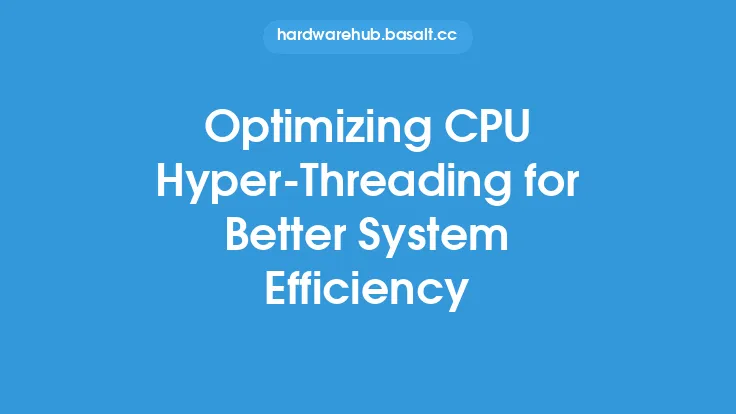When it comes to choosing a processor for your computer, one of the key considerations is the type of threading it uses. Threading refers to the way a processor handles multiple tasks or threads of execution. There are two main types of threading: single-threading and hyper-threading. In this article, we'll explore the differences between these two types of threading and help you determine which one is better for your needs.
Introduction to Single-Threading
Single-threading is a type of threading where each core of a processor can only handle one thread of execution at a time. This means that if you have a processor with multiple cores, each core can only execute one task at a time. Single-threading is the traditional way of handling threads and is still used in many processors today. The main advantage of single-threading is that it is simple to implement and requires less complex hardware. However, it can lead to underutilization of resources, as each core can only handle one task at a time.
Introduction to Hyper-Threading
Hyper-threading, on the other hand, is a type of threading that allows each core of a processor to handle multiple threads of execution simultaneously. This is achieved through a technique called simultaneous multithreading (SMT), which allows multiple threads to share the same execution resources. Hyper-threading was first introduced by Intel in 2002 and has since become a standard feature in many of their processors. The main advantage of hyper-threading is that it can improve the overall performance and efficiency of a processor, especially in multitasking environments.
Key Differences Between Hyper-Threading and Single-Threading
So, what are the key differences between hyper-threading and single-threading? The main difference is the way each core handles threads. In single-threading, each core can only handle one thread at a time, while in hyper-threading, each core can handle multiple threads simultaneously. This means that hyper-threading can provide better performance and efficiency in multitasking environments, as each core can handle multiple tasks at the same time. Another key difference is the complexity of the hardware required to implement each type of threading. Hyper-threading requires more complex hardware, as it needs to be able to handle multiple threads simultaneously, while single-threading is simpler to implement.
Performance Comparison
In terms of performance, hyper-threading generally provides better results than single-threading, especially in multitasking environments. This is because hyper-threading can handle multiple threads simultaneously, which can improve the overall performance and efficiency of a processor. However, the performance difference between hyper-threading and single-threading can vary depending on the specific application and workload. For example, in applications that are heavily dependent on single-threaded performance, such as gaming, single-threading may provide better results. On the other hand, in applications that are heavily dependent on multitasking, such as video editing or 3D modeling, hyper-threading may provide better results.
Power Consumption and Heat Generation
Another important consideration when choosing between hyper-threading and single-threading is power consumption and heat generation. Hyper-threading generally requires more power and generates more heat than single-threading, as it needs to handle multiple threads simultaneously. This can be a concern in mobile devices or other applications where power consumption and heat generation are critical. However, many modern processors are designed to be power-efficient and can handle the increased power requirements of hyper-threading.
Conclusion
In conclusion, the choice between hyper-threading and single-threading depends on your specific needs and requirements. If you need a processor that can handle multiple tasks simultaneously and provide better performance and efficiency in multitasking environments, hyper-threading may be the better choice. On the other hand, if you need a processor that can provide better single-threaded performance and is simpler to implement, single-threading may be the better choice. Ultimately, the decision between hyper-threading and single-threading will depend on your specific use case and requirements. By understanding the differences between these two types of threading, you can make an informed decision and choose the processor that best meets your needs.





